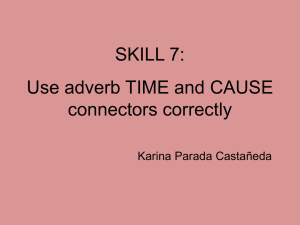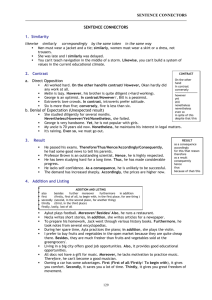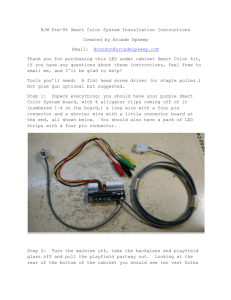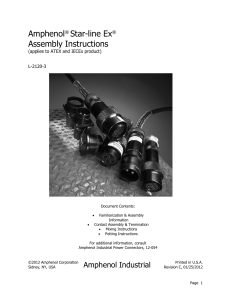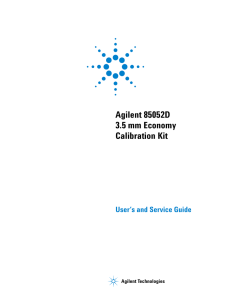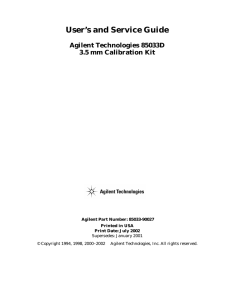QualifiedUserQuiz_Rev2
advertisement
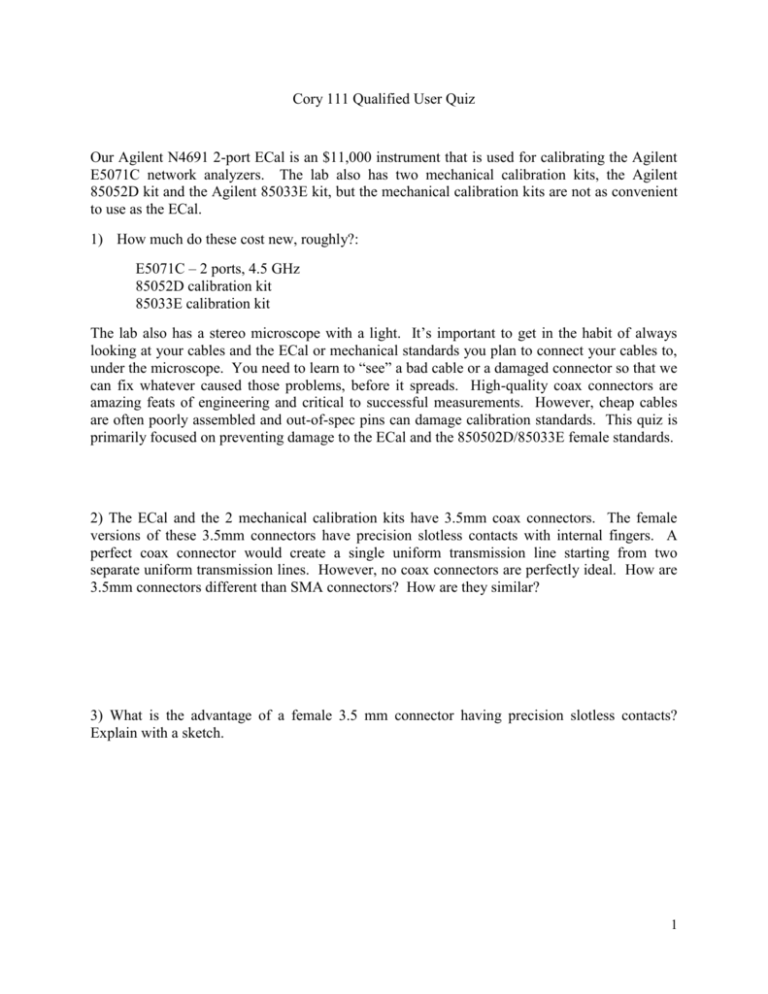
Cory 111 Qualified User Quiz Our Agilent N4691 2-port ECal is an $11,000 instrument that is used for calibrating the Agilent E5071C network analyzers. The lab also has two mechanical calibration kits, the Agilent 85052D kit and the Agilent 85033E kit, but the mechanical calibration kits are not as convenient to use as the ECal. 1) How much do these cost new, roughly?: E5071C – 2 ports, 4.5 GHz 85052D calibration kit 85033E calibration kit The lab also has a stereo microscope with a light. It’s important to get in the habit of always looking at your cables and the ECal or mechanical standards you plan to connect your cables to, under the microscope. You need to learn to “see” a bad cable or a damaged connector so that we can fix whatever caused those problems, before it spreads. High-quality coax connectors are amazing feats of engineering and critical to successful measurements. However, cheap cables are often poorly assembled and out-of-spec pins can damage calibration standards. This quiz is primarily focused on preventing damage to the ECal and the 850502D/85033E female standards. 2) The ECal and the 2 mechanical calibration kits have 3.5mm coax connectors. The female versions of these 3.5mm connectors have precision slotless contacts with internal fingers. A perfect coax connector would create a single uniform transmission line starting from two separate uniform transmission lines. However, no coax connectors are perfectly ideal. How are 3.5mm connectors different than SMA connectors? How are they similar? 3) What is the advantage of a female 3.5 mm connector having precision slotless contacts? Explain with a sketch. 1 4) On these 3.5mm and/or SMA connectors, where is the mating plane? What does that even mean? Explain with a sketch (i.e. when the female and male connectors are mated, what parts are supposed to touch first)? Mating reference plane is where on each connector? 5) The fingers inside the precision slotless center contact of the female 3.5mm connectors can easily be crushed/broken if the user isn’t careful. There are two main ways this can happen: 1) the cable’s male pin is out of spec in the positive direction, and 2) the user rotates the female standard rather than the male connector’s nut. Explain these two catastrophes. Use a sketch to show how the fingers can break. 6) We have a Maury Microwave A027A gage kit in the lab. Explain how to use it to avert catastrophe 1) above. Where can you look to find the specs for pin depth and dielectric depth for 3.5mm connectors and SMA connectors? 2 7) To avert catastrophe 2) above, you should push the cable’s male pin straight into the female connector and then finger tighten the nut. Then you should use 2 wrenches (torque wrench and open-end wrench) to apply the appropriate torque to the connection. If the connection is overtorqued, what’s the problem? Why should you start the 2 wrenches off at an initial angle that is less than 90 degrees? 8) If your pin-depth or dielectric-depth gage tells you that a cable is out of spec in the negative direction, what should you do with the cable? Explain how a bad cable can act like a virus in the lab and “infect”, and break, expensive precision equipment (ECal, mechanical calibration standards, network analyzers). 9) What is a “Connector Saver” and what kind do we have on our network analyzers? What is the problem with their rubber gaskets? 10) The network analyzers can be damaged if too much power (say from an amplifier you’re testing whose input is connected to Port 1 and whose output is connected to Port 2) is applied to Port 2. You may need to reduce the power level that the network analyzer puts out on Port 1. Where do you find this power setting menu on the network analyzer (i.e. which hard key do you need to press to find this Power submenu)? 3 11) Lab etiquette is to clean your bench before you leave the lab (drag the trash can over to your bench and brush all the bits of wire and solder into the trash can). If you’re the last one out of the lab, you should check the 85052D and 85033E cal kits and make sure all the standards have been put back in there (i.e. check the benches to make sure none have been left out). If you’ve been using the soldering iron, you should always tin the tip before you leave. Explain what it means to tin a soldering iron’s tip and why it’s a good idea. 4



